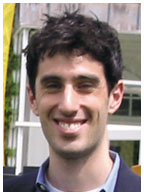Have an opinion about this issue of PAW? Please take a minute to click here and fill out our online questionnaire. It’s an easy way to let the editors know what you like and dislike, and how you think PAW might do better. (All responses will be anonymous.) |
May 11, 2005: From the Editor
Richard Just ’01 (courtesy Richard Just ’01) |
It was Alumni Day, 1958, and President Robert Goheen ’40 *48 was speaking to Princetonians about one of the best-known — and controversial, even then — features of University life: the eating clubs, and options for students who didn’t belong.
“No mature observer close to the Princeton scene could fail to see today that the postwar years have brought severely increased pressures upon the working of the club system and have made it increasingly disruptive of academic life,” Goheen said. “This is not because of the nature of the clubs. It is an inevitable accompaniment of the enlarged and more variegated and — I make bold to say, more seriously minded — undergraduate body of the past 15 years.” Supplementing students’ social and dining options, he said, was “a high priority.”
Goheen was speaking about a student body that had swelled with veterans and included small but growing numbers of Jews, minority students, and others from backgrounds that traditionally had been poorly represented at Princeton. But to those on campus today, as the University prepares for larger classes with ever-more-qualified students coming from many backgrounds and regions around the world, Goheen’s words might ring familiar.
On page 30 in this issue, Richard Just ’01, a former editor of the Daily Princetonian, considers the role of the eating clubs in building community at Princeton — at today’s Princeton, which Just knows well, and the Princeton of half a century ago. As in previous generations, the majority of upperclass students today join clubs; University administrators estimate the figure at 70 percent. But while many students find a warm and welcoming home in the club system, not everyone is happy with it.
Today, a University task force is studying ways to improve social and dining options in the expanded residential college system, to supplement what the clubs offer. “We’re all hoping for a residential college plan that will create more fluidity in the interactions between students who are in the colleges, those who are in clubs, and those who choose to be independent,” says Janet Smith Dickerson, vice president for campus life. “The boundaries are somewhat sharp now, and we have students who report feeling that they are not included in Princeton’s distinctive social community. Our goal is to develop a system where everyone has a sense of belonging.” (For another view, click here to read the President’s Page.)
It’s likely that adjustments will be made on both sides of Washington Road.
Eating clubs are a topic on which Princetonians have strong and varied
opinions, and we would like to hear yours. How can this old tradition
become more effective in building true community among Princetonians today?
Write to PAW at paw@princeton.edu
or 194 Nassau St., Suite 38, Princeton, N.J., 08542. We will publish responses
in our letters column and at www.princeton.edu/paw.
![]()
![]()
Marilyn H. Marks *86
mmarks@princeton.edu


